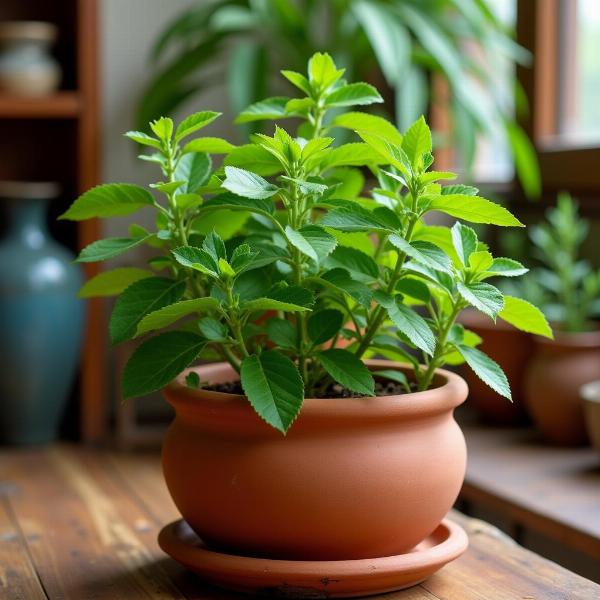Understanding the meaning of “planter” in Hindi can be more nuanced than a simple translation. While the most common equivalent is गमला (gamla), which refers to a pot or container for plants, the word “planter” can encompass various meanings depending on the context. This article will explore the different meanings of “planter” in Hindi, covering everything from simple flower pots to large plantation owners. We’ll also delve into related terms, cultural significance, and practical applications.
Different Meanings of “Planter” in Hindi
The meaning of “planter” in Hindi varies based on whether you are referring to a container, a tool, or a person involved in agriculture. Let’s break down these distinctions:
Planter as a Container (गमला – Gamla)
This is the most common understanding of “planter” in Hindi. गमला (gamla) refers to any container, typically made of clay, plastic, or terracotta, used for growing plants. From small pots for herbs to large decorative containers for trees, गमला encompasses a wide range of sizes and materials. You might also hear the words क्यारी (kyari) or फूलदान (phooldan) used, which refer to flower beds or vases, respectively.
Planter as a Planting Tool (रोपक – Ropak or पौधा लगाने वाला उपकरण – Paudha Lagane Wala Upakaran)
In some contexts, “planter” might refer to a tool used for planting. While there isn’t one single perfect translation, रोपक (ropak) which means “planter” or “sower,” can be used. A more descriptive phrase is पौधा लगाने वाला उपकरण (paudha lagane wala upakaran), meaning “tool for planting saplings.” This encompasses tools like dibblers or bulb planters.
Planter as a Plantation Owner (बागान मालिक – Bagan Malik or ज़मींदार – Zamindar)
Historically, “planter” also referred to a person who owned and managed a large plantation, particularly in colonial contexts. In Hindi, this can be translated as बागान मालिक (bagan malik), meaning “garden owner,” or ज़मींदार (zamindar), which refers to a landowner or landlord. The latter term carries historical weight, often associated with large landholdings and a specific social class.
Understanding the Context
Knowing the right Hindi word for “planter” depends heavily on the context. Are you discussing gardening at home? Are you talking about agricultural practices? Or are you referring to historical contexts? Clarifying the context will help you choose the most appropriate term.
Examples of Usage
- “I bought a new planter for my basil.” – “मैंने अपने तुलसी के लिए एक नया गमला खरीदा।” (Maine apne tulsi ke liye ek naya gamla kharida.)
- “The planter used a special tool to sow the seeds.” – “रोपक ने बीज बोने के लिए एक विशेष उपकरण का उपयोग किया।” (Ropak ne beej bone ke liye ek vishesh upakaran ka upyog kiya.)
- “The planters of the colonial era held significant power.” – “औपनिवेशिक युग के ज़मींदारों के पास महत्वपूर्ण शक्ति थी।” (Aupniveshik yug ke zamindaron ke paas mahatvpurn shakti thi.)
Cultural Significance of Plants and Planters in India
Plants and planters hold significant cultural importance in India. From religious rituals to everyday life, plants are revered and symbolize prosperity, good health, and positive energy. The use of gamlas for growing Tulsi (holy basil) is a prime example of this cultural significance.
Choosing the Right Planter
If you’re looking to buy a planter (गमला) in India, you have numerous options. Consider the size and type of plant, the material of the planter, and the overall aesthetic you want to achieve. Terracotta pots are traditional and porous, allowing for good drainage, while plastic pots are lightweight and affordable.
 Tulsi Plant in a Gamla
Tulsi Plant in a Gamla
Conclusion
Understanding the various meanings of “planter” in Hindi can enhance your communication and understanding of Indian culture. Whether you are talking about a simple गमला (gamla), a planting tool (रोपक – ropak), or a historical ज़मींदार (zamindar), choosing the correct term is crucial for clear communication. By exploring these nuances, you gain a deeper appreciation for the rich language and traditions surrounding plants and agriculture in India.
FAQ
- What is the most common Hindi word for planter? The most common word is गमला (gamla).
- What are some other words for planter in Hindi? Other words include क्यारी (kyari), फूलदान (phooldan), रोपक (ropak), बागान मालिक (bagan malik), and ज़मींदार (zamindar).
- What is the cultural significance of plants in India? Plants are revered and symbolize prosperity, health, and positive energy.
- What are some common materials for planters in India? Common materials include terracotta, plastic, and ceramic.
- What should I consider when choosing a planter? Consider the plant’s size, the material of the planter, and the desired aesthetic.
- What does ज़मींदार mean? ज़मींदार refers to a landowner, often associated with large landholdings and a specific social class.
- What is the difference between गमला and फूलदान? गमला is a general term for a plant pot, while फूलदान specifically refers to a vase for flowers.
Meaning-Hindi.in is your one-stop solution for all your Hindi translation needs. We specialize in various translation services, including business and commercial document translation, certified and legal document translation, technical and user manual translation, website and localization translation, educational and academic document translation, express translation, and specialized industry translation. Need accurate and culturally sensitive translations? Contact us at [email protected] or call us at +91 11-4502-7584. Meaning-Hindi.in is committed to providing high-quality, reliable translations that bridge the language gap and facilitate effective communication.